Paint a Red Cardinal in 3 Easy Steps
Start by gathering high-quality acrylic paints, brushes, and setting up your workspace in a well-lit area. Analyze the cardinal's anatomy, focusing on the plumage, beak, crest, and black mask.
Roll up your sleeves and start sketching. Use basic shapes for the body, head, tail, and beak.
Next, block in vibrant reds and cooling shadows to set the stage for shape and depth. Layer individual feathers using differing red tones, including touches of orange and yellow for detail.
Enhance your painting with light and shadow techniques for realism, expressing your unique interpretation through art. Preserve your artwork appropriately.
But hold on, there's more to the art of capturing the essence of a red cardinal!
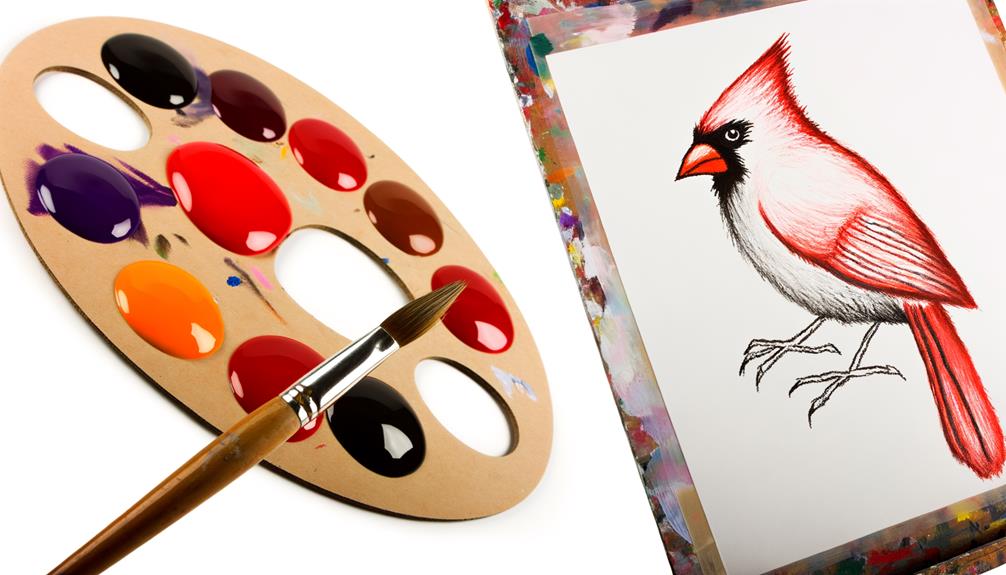
Key Takeaways
- Start by sketching the cardinal using basic shapes, focusing on features like the crest, beak, and wings.
- Block in colors using vibrant hues, primarily red for the body and blue for shadows, to create depth.
- Paint the red feathers by applying varied tones of red, adding touches of orange and yellow for highlights.
- Use light and shadow effects to enhance the depth and realism of the painting, replicating how they behave in nature.
- Preserve the artwork using a UV-protective varnish, storing it under ideal conditions and using acid-free mats for framing.
Gathering Your Painting Supplies
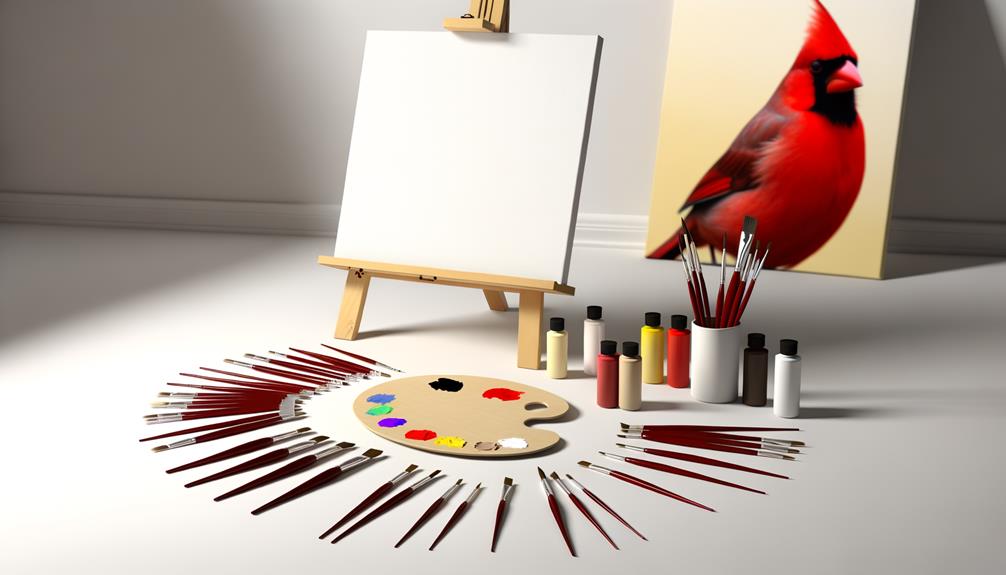
Before you immerse yourself in painting a vibrant red cardinal, you'll need to assemble your essential painting supplies. Pick up a set of quality brushes – a larger one for broad strokes and a fine one for detailing.
Choose acrylic paints for their versatility and ease of use. You'll need a palette of primary colors, plus black and white for mixing. Grab a sturdy canvas or sketchpad, depending on your preference.
A palette knife is handy for blending colors, and don't forget a jar of water for cleaning brushes. Finally, set up a comfortable workspace with good lighting. Remember, the freedom to create starts with the right tools at your fingertips.
Now, you're ready to begin your cardinal painting journey.
Understanding Cardinal Anatomy
Before you can capture the stunning beauty of the red cardinal on canvas, it's essential to understand its unique anatomy.
You'll need to study and appreciate the cardinal's physical features, from its vibrant plumage to its distinctive beak.
This knowledge will empower you to render a more accurate and artistically compelling depiction of this breathtaking bird.
Cardinal Physical Features
To accurately paint a red cardinal, it's essential you understand its distinct physical features, such as its bright red plumage and the black mask surrounding its beak. This alluring bird is radiantly clad in scarlet from head to tail, a vibrant hue that captures the eye and heart.
The black mask is a distinctive trait, encircling the beak like a bandit's disguise. It's accentuated by a pointed crest, which adds an aristocratic flair to its appearance.
The underparts are a softer pink-red, contrasting the rich, fiery red of the upper parts. Its beak is a strong, conical shape, perfect for cracking seeds, and is a striking orange color.
The cardinal's wings, although primarily red, sport touches of black near the shoulders. This is your cardinal, a masterpiece of nature waiting for your artistic touch.
Anatomy for Artistic Depiction
Now that you're familiar with the cardinal's vibrant physical features, let's hone in on its detailed anatomy which will guide your artistic depiction.
You'll notice that the cardinal's body is compact and robust, befitting its energetic nature. Its head is proportionately large with a strong, conical beak that's perfect for seed-cracking.
The wings, broad and powerful, are designed for swift, direct flight. The tail is notched, slightly longer in males than females. These anatomical nuances are the foundation of your creative endeavor, giving your artwork a touch of realism.
As you move your brush, imagine the cardinal's freedom in flight, its strength in survival. Remember, painting isn't just about replication, but also about capturing the essence of your subject.
Sketching a Cardinal Outline
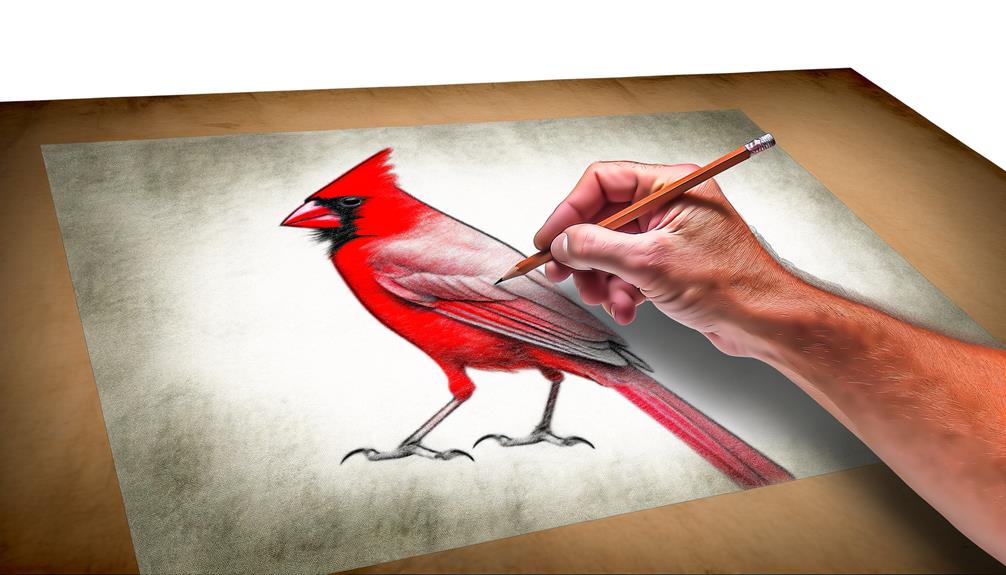
While sketching your cardinal, it's important to start with a basic outline to capture the bird's distinctive shape and features accurately. Begin with a light, free-flowing pencil stroke to create an oval for the body, a smaller circle for the head, and triangles for the tail and beak. Remember, it's fine to be loose and abstract at this stage. You're not aiming for perfection here, but rather a basic framework on which to build.
Next, draw the cardinal's crest, a signature feature of this bird, using soft, curved lines. Pay attention to the bird's eyes, they're vital for capturing its character.
Now, outline the wings and feet.
With that, your cardinal sketch is complete. You're ready to move onto the next step – adding color.
Blocking in Basic Colors
Diving into the world of color, let's start by using bold, vibrant hues to bring your cardinal sketch to life.
Grab your paintbrush and select a medium red from your palette. Apply this as a base color, blocking in the major sections of the bird that'll be red. It's important to keep your strokes loose and fluid, allowing your creativity to flow freely.
Next, take a deep, cool blue for the shadows. Don't be shy to exaggerate these areas, as it'll add depth to your painting.
Painting the Cardinal's Red Feathers
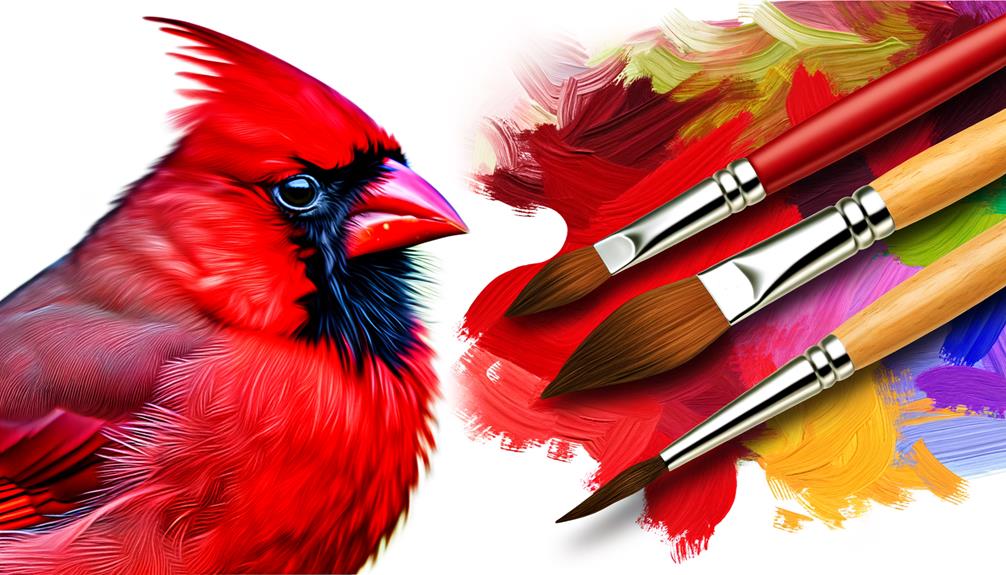
It's time to turn your attention to the cardinal's red feathers, the vibrant feature that makes this bird so distinctive. Embrace the freedom to let your creativity shine in this stage.
Begin by applying a base layer of bright red. This serves as the backdrop for the detailed feather strokes.
Next, with a fine brush, start adding individual feathers. Vary the intensity of red to create depth and texture. Remember, it's not about perfection; it's about capturing the essence of the cardinal.
Finally, add highlights of orange and yellow to reflect the sunlight hitting the feathers.
This process may take time, but don't rush it. Savor each stroke, each color blend. This is your journey to painting a beautiful cardinal.
Detailing the Bird's Face and Beak
Now, let's turn our attention to the cardinal's face and beak.
Start with sketching the facial features, ensuring each detail is just right before moving on to the beak.
With careful strokes, bring the beak to life, focusing on texture and coloring to create a realistic look.
Sketching the Cardinals Face
With keen focus on detail, you'll initiate the sketching process by concentrating on the cardinal's distinct, sharp beak and expressive eyes. Capturing these features accurately is vital as they define the bird's unique character.
To accomplish this, consider these steps:
- Begin by lightly outlining the cardinal's face, allowing room for adjustments and corrections.
- Sketch the beak, paying attention to its pointed shape and the gentle curve at the tip. It's important not to exaggerate this part, you're sketching, not painting.
- Outline the eyes, ensuring they're circular and expressive.
Painting the Beak Details
Moving on to the next phase, you'll explore the meticulous task of painting the cardinal's beak, bringing to life its distinct, pointed shape with a precise blend of colors and brush strokes.
Start with a base coat of bright orange, applying it in smooth, even strokes to capture the beak's curved surface.
Next, add depth to this solid foundation with a darker shade, using thin lines to suggest the fine details and shadows.
Finally, a touch of white at the beak's tip will give it a realistic sheen, emulating the glimmer of sunlight.
Carefully observe your reference photo; each brush stroke is a chance to express the cardinal's unique character.
Adding Background Elements
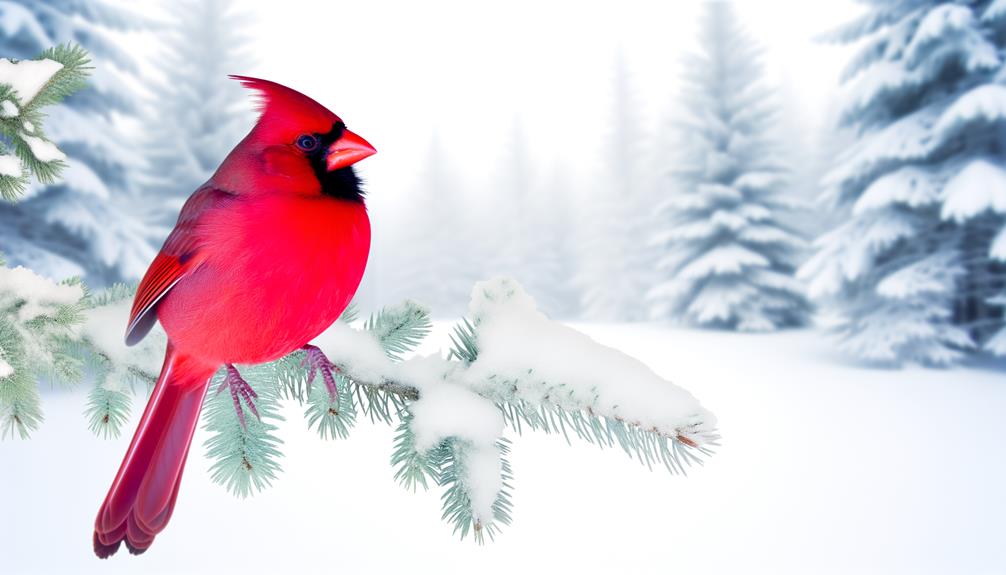
To breathe life into your red cardinal painting, you'll want to introduce background elements that help anchor your subject in its natural environment. These elements provide context and depth, transforming your piece from a simple bird portrait to a lively nature scene.
Consider the following steps:
- Choose a Setting: Whether it's a snow-laden forest or a vibrant summer meadow, pick a place that complements the cardinal's fiery plumage.
- Add Flora: Introduce trees, shrubs, or flowers. These not only enhance the aesthetics but also give the bird a perch, making the scene more believable.
- Incorporate Fauna: Small insects or fellow birds can add movement and dynamism.
Fine-tuning and Adding Shadows
Once you've woven in the lush backdrop, it's time you focus on fine-tuning the details and casting shadows on your red cardinal painting, thereby adding depth and a touch of realism.
Use a small brush to delineate the bird's feathers, eyes, and beak with precision, fostering a tangible sense of life and vibrancy.
For shadows, choose a darker shade of the color present on the surface where the shadow falls. Observe how light behaves in nature, casting shadows that are darker at the base and gradually lightening.
This isn't just about replication, but about breathing life into your painting.
The freedom to paint is yours, and with each brushstroke, you're not just creating art, but also expressing your unique interpretation of the world.
Tips for Preserving Your Artwork

Protecting your masterpiece's longevity with the right preservation practices can help keep your red cardinal painting vibrant and alive for years to come. The freedom to create is nothing without the ability to sustain.
Here are three tips to maximize your artwork continues to shine:
- Use a UV-protective varnish: This shields your painting from harmful sun rays that can fade the vibrant red of your cardinal.
- Store in ideal conditions: Avoid damp, hot, or overly bright places. A temperature-controlled room with moderate lighting is preferred.
- Frame it correctly: Use acid-free mats and UV-protected glass. They'll safeguard your painting from external elements while preserving its original colors.
Conclusion
You've journeyed back in time, from gathering your tools to mastering the intricate red feathers, and now your cardinal takes flight on canvas.
Don't forget the finishing touches: shadows to add depth, and a protective varnish to shield your masterpiece from the ravages of time.
Painting a cardinal isn't just an art, it's a timeless adventure.
Bravo on creating a slice of nature's beauty, a vivid red cardinal that will endure the test of time.






